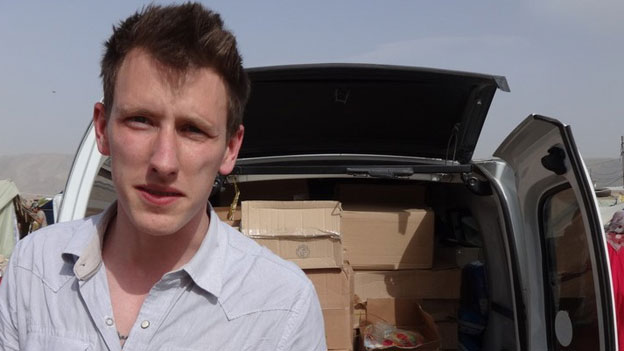
BEIRUT — An Islamic State group video released Sunday purports to show extremists beheading a dozen Syrian soldiers and ends with a militant claiming to have killed U.S. aid worker Peter Kassig, the latest slaughter proudly broadcast by the group on the Internet.
The video ends with the militant standing over a severed head he says belongs to Kassig. U.S. officials said they were working to determine the video’s authenticity. Kassig’s family said it was awaiting the outcome of the investigation.
“We prefer our son is written about and remembered for his important work and the love he shared with friends and family, not in the manner the hostage takers would use to manipulate Americans and further their cause,” the family said in a statement.
The Associated Press could not independently verify the footage, though it appeared on websites used in the past by the Islamic State group, which now controls a third of Syria and Iraq.
The video identifies the militants’ location as Dabiq, a town in northern Syria that the militant group uses as the title of its English-language propaganda magazine and where they believe an apocalyptic battle between Muslims and their enemies will occur.
The high-definition video shows the beheadings of about a dozen men identified as Syrian military officers and pilots, all dressed in blue jumpsuits. The main militant in the video who speaks to the camera has a British accent and warns that U.S. soldiers will meet a similar fate.
“We say to you, Obama: … You claim to have withdrawn from Iraq four years ago,” the militant said. “Here you are: You have not withdrawn. Rather, you hid some of your forces behind your proxies.” A U.S.-led coalition is targeting the Islamic State group in airstrikes, supporting Western-backed Syrian rebels, Kurdish fighters and the Iraqi military.
The militant’s voice is distorted in the video. Previous videos featured a militant with a British accent that the FBI says it has identified, though it hasn’t named him publicly.
Later, the militant claims Kassig, 26, was killed because he “fought against the Muslims in Iraq while serving as a soldier.” Kassig, from Indianapolis, Indiana, served in the U.S. Army’s 75th Ranger Regiment, a special operations unit, and deployed to Iraq in 2007.
After being medically discharged, Kassig formed the aid organization Special Emergency Response and Assistance, or SERA, in Turkey to aid Syrian refugees. He delivered food and medical supplies and provided trauma care to wounded Syrian civilians before being captured in eastern Syria last year. Friends say he converted to Islam in captivity and took the first name Abdul-Rahman.
Burhan Agha, a Syrian friend who worked with Kassig in Lebanon and who moved to Switzerland seeking asylum, wept when recounting his generosity Sunday.
“If I could apologize to each American, one by one, I would, because Peter died in Syria, while he was helping the Syrian people,” Agha told the AP by telephone. “Those who killed him claimed to have done it in the name of Islam. I am a Muslim and am from Syria. … (His killers) are not Muslims.”
The White House said the U.S. intelligence community was examining the video. National Security Council spokeswoman Bernadette Meehan said that if the video is authentic, the White House would be “appalled by the brutal murder of an innocent American.” British Prime Minister David Cameron said he was “horrified by the cold-blooded murder,” saying that the Islamic State group has “again shown their depravity.”
Previous videos have shown the beheading of two American journalists and two British aid workers. The latest video did not show the person identified as Kassig being beheaded. Unlike previous videos, it did not show other Western captives or directly threaten to behead anyone else. It also had lingering close-ups on some miltiants’ exposed faces, with a few appearing to be foreigners.
The Islamic State group holds British photojournalist John Cantlie, who has appeared in several videos delivering statements for the group, likely under duress. They also hold a 26-year-old American woman captured last year in Syria while working for aid groups. U.S. officials have asked that the woman not be identified out of fears for her safety.
The Islamic State group has beheaded and shot dead hundreds of captives – mainly Syrian and Iraqi soldiers – during its sweep across the two countries, and has celebrated its mass killings in extremely graphic videos.
The group has declared a self-styled Islamic caliphate in the areas under its control, which it governs according to its violent interpretation of Shariah law.
On Sunday, the Islamic State group claimed a bombing at the Baghdad International Airport that wounded five people, saying it was trying to strike Americans there. No one was wounded in a passing United Nations convoy, the organization said.
The Islamic State group has its roots in al-Qaida’s Iraqi affiliate but was expelled from the global terror network over its brutal tactics and refusal to obey orders to confine its activities to Iraq. It became even more extreme amid the bloody civil war in neighboring Syria and grew strong enough to launch a lightning offensive across Iraq.
Syria’s war began as an uprising against President Bashar Assad. Activists say that conflict has killed more than 200,000 people.
Associated Press writers Julie Pace in Brisbane, Australia, David Aguilar in Detroit, Jon Gambrell in Cairo and Vivian Salama in Baghdad contributed to this report.